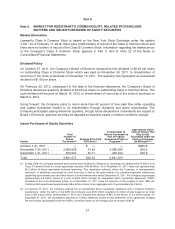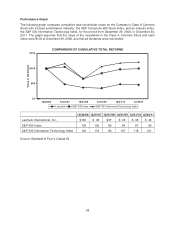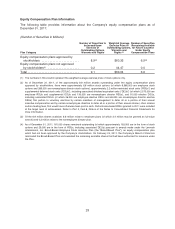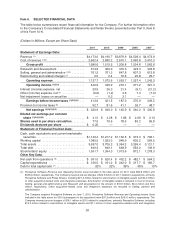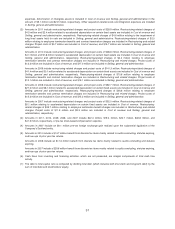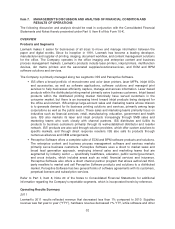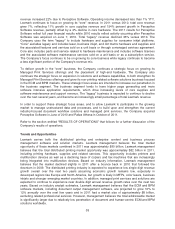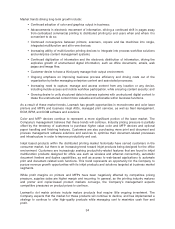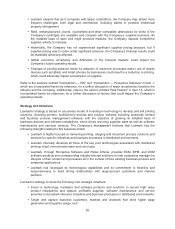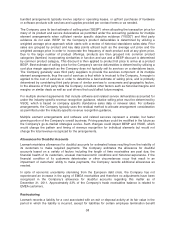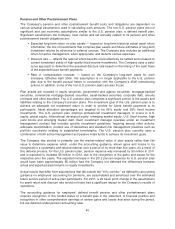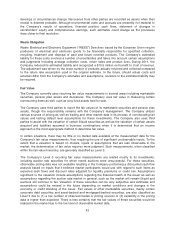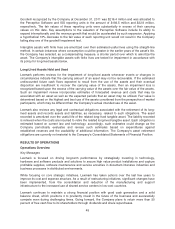Lexmark 2011 Annual Report Download - page 41
Download and view the complete annual report
Please find page 41 of the 2011 Lexmark annual report below. You can navigate through the pages in the report by either clicking on the pages listed below, or by using the keyword search tool below to find specific information within the annual report.• Advancing and growing the Company’s ECM and BPM business worldwide.
Refer to the section entitled “Strategy” in Item 1, which is incorporated herein by reference, for a further
discussion of the Company’s strategies and initiatives.
CRITICAL ACCOUNTING POLICIES AND ESTIMATES
Lexmark’s discussion and analysis of its financial condition and results of operations are based upon
the Company’s consolidated financial statements, which have been prepared in accordance with
accounting principles generally accepted in the U.S. The preparation of consolidated financial
statements requires management to make estimates and judgments that affect the reported amounts
of assets, liabilities, revenue and expenses, as well as disclosures regarding contingencies. On an
ongoing basis, the Company evaluates its estimates, including those related to customer programs and
incentives, product returns, doubtful accounts, inventories, stock-based compensation, intangible
assets, income taxes, warranty obligations, copyright fees, restructurings, pension and other
postretirement benefits, contingencies and litigation, long-lived assets and fair values that are based on
unobservable inputs significant to the overall measurement. Lexmark bases its estimates on historical
experience, market conditions, and various other assumptions that are believed to be reasonable
under the circumstances, the results of which form the basis for making judgments about the carrying
values of assets and liabilities that are not readily apparent from other sources. Actual results may
differ from these estimates under different assumptions or conditions.
An accounting policy is deemed to be critical if it requires an accounting estimate to be made based on
assumptions about matters that are uncertain at the time the estimate is made, if different estimates
reasonably could have been used, or if changes in the estimate that are reasonably likely to occur
could materially impact the financial statements. The Company believes the following critical
accounting policies affect its more significant judgments and estimates used in the preparation of its
consolidated financial statements.
Revenue Recognition
See Note 2 of the Notes to the Consolidated Financial Statements in Part II, Item 8 for information
regarding the Company’s policy for revenue recognition. For customer programs and incentives,
Lexmark records estimated reductions to revenue at the time of sale for customer programs and
incentive offerings including special pricing agreements, promotions and other volume-based
incentives. Estimated reductions in revenue are based upon historical trends and other known factors
at the time of sale. Lexmark also records estimated reductions to revenue for price protection, which it
provides to substantially all of its distributor and reseller customers. The amount of price protection is
limited based on the amount of dealers’ and resellers’ inventory on hand (including in-transit inventory)
as of the date of the price change. If market conditions were to decline, Lexmark may take actions to
increase customer incentive offerings or reduce prices, possibly resulting in an incremental reduction of
revenue at the time the incentive is offered.
The Company also records estimated reductions to revenue at the time of sale related to its customers’
right to return product. Estimated reductions in revenue are based upon historical trends of actual
product returns as well as the Company’s assessment of its products in the channel. Provisions for
specific returns from large customers are also recorded as necessary.
Multiple Element Arrangements
The Company also enters into multiple element agreements with customers which involve the
provisions of hardware and/or software, supplies, customized services such as installation,
maintenance, and enhanced warranty services, and separately priced maintenance services. These
37


